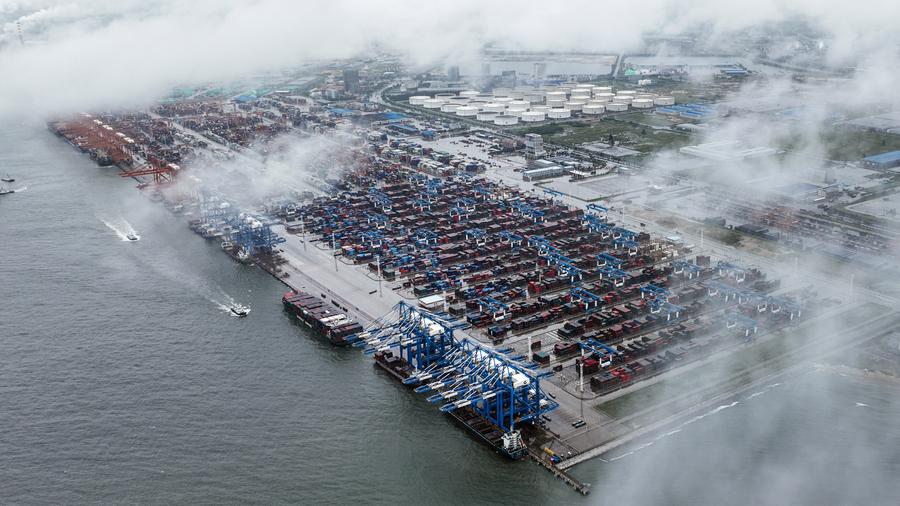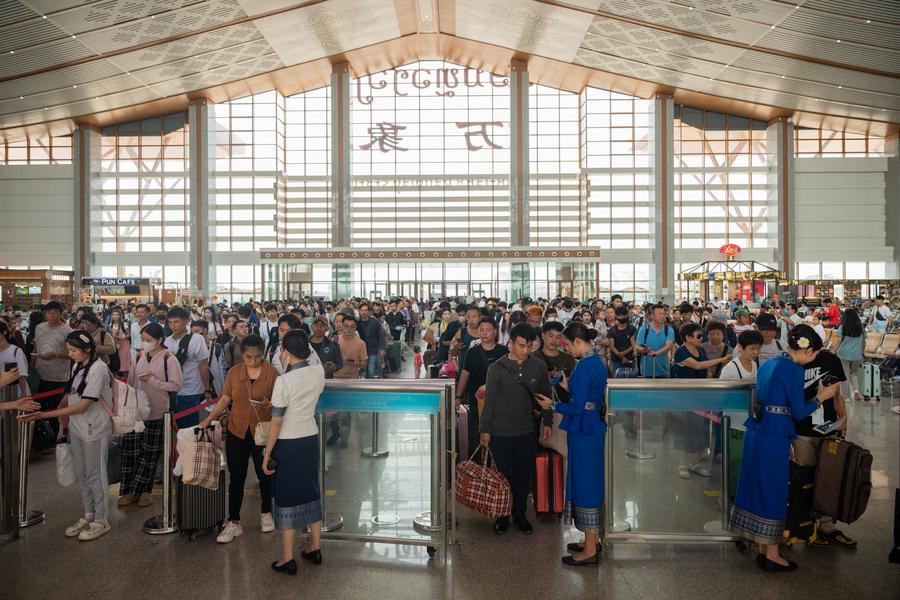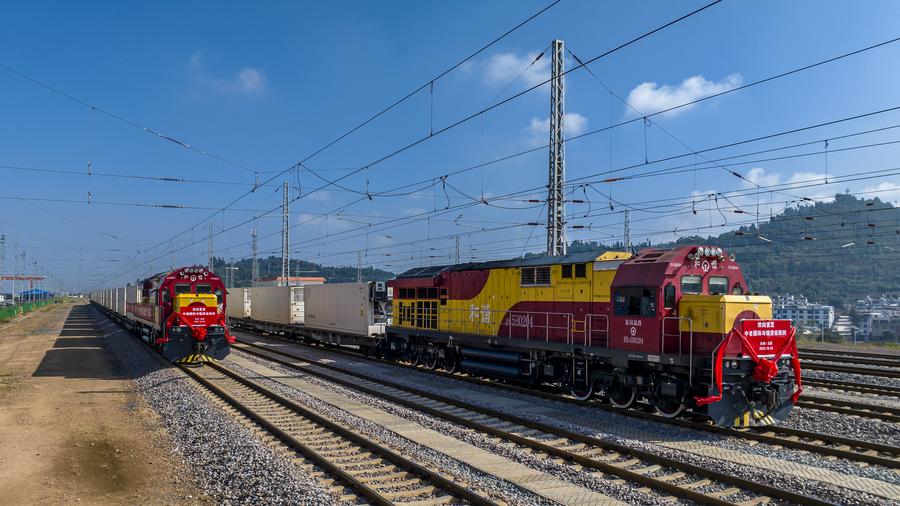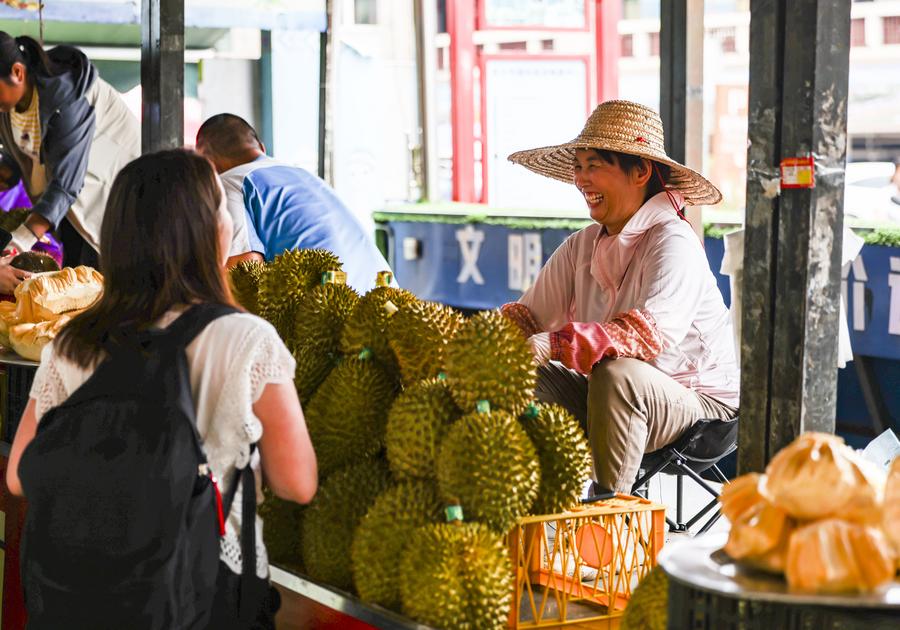


An aerial drone photo taken on July 31, 2024 shows a view of Qinzhou Port in Qinzhou, south China's Guangxi Zhuang Autonomous Region. (Xinhua/Zhang Ailin)
While pursuing high-quality development and advancing modernization, China has been offering new growth momentum to its neighbors, said experts ahead of Chinese Premier Li Qiang's trip to Laos and Vietnam.
BEIJING, Oct. 8 (Xinhua) -- Chinese Premier Li Qiang will attend the 27th China-ASEAN Summit, the 27th ASEAN Plus Three Summit and the 19th East Asia Summit in the Lao capital Vientiane starting from Wednesday, and pay official visits to Laos and Vietnam.
While pursuing high-quality development and advancing modernization, China has been offering new growth momentum to its neighbors connected by mountains and rivers, notably through Belt and Road cooperation with common development being a highlight.
Experts said that Li's upcoming trip to the Association of Southeast Asian Nations (ASEAN) is expected to boost bilateral relations, foster deeper and more substantive cooperation, and enhance people-to-people exchanges, which will further catalyze regional peace, stability and prosperity.
ENHANCING CONNECTIVITY
Laos is a landlocked country in Southeast Asia. Its landscape, largely covered by rugged mountains and high plateaus, forms natural barriers to efficient transportation, hindering the country's development and the improvement of people's livelihood.
The China-Laos Railway has helped transform the country's predicament into a growth opportunity, turning Laos into a land-linked hub on the Indo-China Peninsula.

Passengers are seen at the Vientiane Station of the China-Laos Railway in Vientiane, Laos, April 11, 2024. (Photo by Kaikeo Saiyasane/Xinhua)
The 1,035-km railway, a landmark Belt and Road project, connects Kunming in southwest China's Yunnan Province with Vientiane.
Nearly three years into operation, the railway has handled over 10 million tons of imported and exported goods valued at about 5.7 billion U.S. dollars in total, with varieties of goods expanding from the initial 500 to more than 3,000, according to official data.
Since the railway launched its international passenger service in April 2023, it has transported over 222,000 cross-border passengers as of early July this year, providing affordable, convenient and comfortable experiences to travelers.
Daovone Phachanthavong, vice executive president of the Lao National Chamber of Commerce and Industry, told Xinhua the China-Laos Railway "has promoted regional connectivity and injected vitality into economic and social development along the line."
Vietnam, a neighbor of Laos, has enjoyed enhanced connectivity and more efficient logistics from infrastructure cooperation with China as well, which includes railway, expressway and port infrastructure.
China-Vietnam freight trains are a good case in point. Since its launch in November 2017, the service has significantly boosted rapid cargo movement between the two countries and further into Southeast Asia.
"China has strengths in capital, technology, and experience in infrastructure construction, while Vietnam is in need of infrastructure development in transportation, energy, and urban areas," said Do Thi Thu, a senior lecturer at the Banking Academy of Vietnam.

This aerial photo taken on Oct. 16, 2023 shows a China-Vietnam (L) and a China-Laos international cold-chain freight trains pulling out of Yanhe Station of Yuxi City, southwest China's Yunnan Province. (Photo by Chen Chang/Xinhua)
BOOMING HIGH-QUALITY DEVELOPMENT
Infrastructure construction has opened up broader prospects for practical cooperation between China and ASEAN countries in a rich variety of areas, driving stronger economic growth, closer exchanges and high-quality development.
China is the largest foreign investor in Laos. A large chunk of the investment has funded infrastructure, development zones, as well as power transmission lines and hydropower plants, creating many jobs for local people and pushing forward Laos' industrial upgrade.
Daovone said that Laos sees huge potential for further deepening cooperation with China across such fields as agriculture, electric vehicles and trucks, electricity, mining, solar energy, tourism, as well as hotels and restaurants.
Agriculture is the mainstay of the Lao economy. Laos exports bananas, rubber, cassava, sugarcane and others, with China being the largest buyer.
Through the years, Chinese companies have collaborated with the Lao government on tropical agricultural science and technology, and Laos is seeking to promote sustainable agricultural production and increase exports to China through the China-Laos Railway.
Vietnam, meanwhile, is China's largest trading partner within ASEAN, and China has been Vietnam's largest trading partner since 2004. Annual volume of two-way trade has exceeded 200 billion U.S. dollars for three consecutive years.
Do, the Hanoi-based scholar, said that Vietnam-China "large cooperative projects on infrastructure, energy, and border area development have contributed to the socio-economic growth of both nations."
Vietnam-China trade cooperation "has bright prospects for deeper and more substantive cooperation in the future," she said.
She also said the introduction of fresh and frozen Vietnamese durians into the Chinese market shows the development of trade cooperation, exemplified by diversifying products within the same category and adding value.
With Chinese consumers' demand for durians on the rise, China is now the world's largest importer and consumer of durians. Last year, some 493,000 tons of fresh Vietnamese durians were sold to China.

Vietnamese vendors sell durians in Dongxing, south China's Guangxi Zhuang Autonomous Region, on May 18, 2023. (Xinhua/Hu Xingyu)
Do also pointed out the abundant opportunities in substantive development of bilateral trade, noting the two countries can further enhance cooperation particularly in high-tech agriculture and e-commerce.
"China has advanced significantly in technology and innovation, while Vietnam is undergoing a digital transformation and developing its digital economy, creating great potential for cooperation in information technology, artificial intelligence, financial technology, and digital transformation in manufacturing," she added.
CLOSER COMMUNITY FOR BROADER PROSPERITY
The flagship projects realized through high-quality cooperation between China and ASEAN nations have become benchmarks of their ever-closer relationships, the strengthening of which is conducive to regional prosperity and peace, experts have said.
This year marks the 15th anniversary of the China-Laos comprehensive strategic cooperative partnership. In October 2023, leaders of the two countries signed a new five-year action plan for building a China-Laos community with a shared future, injecting new momentum into the further development of bilateral ties.

Photo taken on Oct. 16, 2016 shows the border trade on the Beilun River on the China-Vietnam border. (Xinhua/Zhou Hua)
Daovone greatly appreciates the friendship between the two socialist countries, which is maintained by the top leaders of both countries and exchanges between the two peoples.
Laos-China relations have been moving forward at a high level, he said, expressing the hope that Li's upcoming visit to Laos will further advance this relationship. As Laos is the current rotating chair of ASEAN, Li's attendance to related gatherings "will make the summit more colorful."
Vietnam, another socialist neighbor, shares cultural and social affinities with China. Last year, the two countries announced the building of a China-Vietnam community with a shared future that carries strategic significance, ushering in a new stage in their ties.
"Mutual assistance during difficult times, such as supporting each other during the resistance against colonialism and imperialism, post-war reconstruction, and overcoming the COVID-19 pandemic, has strengthened the friendship between our two countries," Do said.
As the world is facing rising challenges and geopolitical competition, "a successful bilateral community like Vietnam-China could inspire other bilateral and multilateral communities with a shared future, such as between China and ASEAN," she said.
Do noted that working towards a community with a shared future helps Vietnam and China focus on sustainable development goals, including environmental protection, climate change response and food security.
"It allows the two countries to address common challenges and promote development for the benefit of their peoples, as well as for peace, stability, and prosperity in the region," she said.
点击右上角![]() 微信好友
微信好友
 朋友圈
朋友圈

请使用浏览器分享功能进行分享
